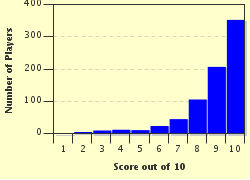Quiz Answer Key and Fun Facts
1. Belarus is a landlocked country in northeastern Europe. With which of these countries does Belarus NOT share a border and significant cultural links?
2. This plaque on Dzyarzhynsk Hill marks a point of geographical significance for the country of Belarus. Which of these is it?
3. In Tom Lehrer's song 'Lobachevsky', the chain of stolen information that is going to allow the singer to succeed in his task of plagiarizing the work of others is said to run, in part, "To Tomsk to Omsk to Pinsk to Minsk". Which of these cities is the largest city and capital of Belarus?
4. The most striking feature of the flag of Belarus is the red and white pattern along its hoist (the part that is next to the flagpole when it is flying). What is the significance of this pattern?
5. This 1992 Belarusian stamp offers a clue as to the religious heritage of the country. Approximately two thirds of Belarusians practice some formal religion. Which of these is by far the most common faith?
6. While not a legislated national emblem, what bird is commonly considered the national bird of Belarus?
7. In the 17th and 18th centuries, a Belarusian art form had its golden age. What medium was used in creating these works of art?
8. Having developed in a cold climate, the cuisine of Belarus is primarily based on soups and stews, accompanied by bread. What traditional soup of beetroot and cabbage, along with other vegetables, is pictured here?
9. Belarusians excel in a number of areas of athletic endeavor. What wintry sport is Belarus's most popular one?
10. One of Belarus's four UNESCO National Heritage sites is the Belavezhskaya Pushcha, a forest on its western border that also extends into neighboring Poland. It is the home for the Belarusian unofficial national animal, the wisent. What kind of animal is the wisent?
Source: Author
looney_tunes
This quiz was reviewed by FunTrivia editor
stedman before going online.
Any errors found in FunTrivia content are routinely corrected through our feedback system.

